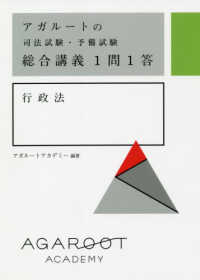Full Description
Translation studies as a discipline has grown enormously in recent decades. Contributions to the discipline have come from a variety of fields, including machine translation, history, literature, philosophy, linguistics, terminology, signed language interpreting, screen translation, translation pedagogy, software localization and lexicography. There is evidently great diversity in translation studies, but is there much unity? Have the different branches of translation studies become so specialized that they can no longer talk to each other? Would translation studies be strengthened or weakened by the search for or the existence of unifying principles?
This volume brings together contributions from feminist theory, screen translation, terminology, interpreting, computer-assisted translation, advertising, literature, linguistics, and translation pedagogy in order to counter the tendency to partition or exclude in translation studies. Machine translation specialists and literary translators should be found between the same book covers, if only because the nomadic journeying of concepts is often the key to intellectual discovery and renewal. Celebrating our differences does not mean ignoring what we have in common. Unity in Diversity offers a valuable overview of the current state of translation studies from both theoretical and practical perspectives and makes an important contribution to debates on the future direction of translation studies.
Contents
partOne The Nature of Translation; Chapter 1 Dis-Unity and Diversity, Luise von Flotow; Chapter 2 Translation, Autobiography, Bilingualism, Susan Ingram; partTwo Translation in National Context; Chapter 3 Antigone, Ian Brown, Ceri Sherlock; Chapter 4 'Genuine' and 'Fictitious' Translations of Science Fiction & Fantasy in Hungary, AnikÓo SohÁar; Chapter 5 Theory and Practice, Paul St-Pierre; Chapter 6 Marginal Forms of Translation in Japan, Judy Wakabayashi; Chapter 7 Choices and Constraints in Screen Translation, Eithne O'Connell; partThree Descriptive Translation Studies; Chapter 8 Six Subtitlers '" Six Subtitling Texts, Irena Kovacic; Chapter 9 Parallel Texts in Translation, Christina SchÄffner; Chapter 10 Bilingual Reference Corpora for Translators and Translation Studies, Carol Peters, Eugenio Picchi; Chapter 11 The English Comparable Corpus, Sara Laviosa; partFour Computer-Aided Translation; Chapter 12 Practical Experience of Computer-Aided Translation Tools in the Software Localization Industry, Sharon O'Brien; Chapter 13 Translation Memories: Insights and Prospects, Matthias Heyn; Chapter 14 Consistency and Variation in Technical Translations, Magnus Merkel; Chapter 15 The Problem with Machine Translation, Reinhard SchÄler; Chapter 16 Machine Translation as a Model of Human Translation, Paul Bennett; partFive Interpreting Studies; Chapter 17 Unity in Diversity, Franz PÖchhacker; Chapter 18 Language Direction and Source Text Complexity, Jorma Tommola, Marketta HelevÄ; Chapter 19 User Responses to Simultaneous Interpreting, Anna-Riitta Vuorikoski;








